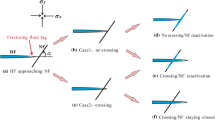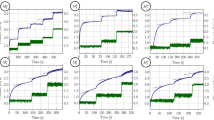Abstract
A method based on modeling a crack by a continuous distribution of dislocations has been used to study the interaction between the wellbore and pressure-induced fractures. This method allows the stress intensity factor and opening of the fractures to be calculated as a function of fracture length, in-situ state of stress, fracture pressure and rock properties. It also allows one to determine the wellbore pressure during quasi-static propagation. Two configurations have been considered in this report; a fracture in which acts a pressure equal to the pressure in the hole (hydraulic fracturing using a perfectly penetrating fluid) and a stress free fracture (i.e. sleeve fracturing or hydraulic fracturing using a non penetrating fluid). These two cases give respectively the lower bound and upper bound for the pressure during a micro-hydraulic fracture experiment.
The pressure behaviour has been found to be strongly dependent on fracture toughness and σ2 for short cracks, but also on the mode of loading (i.e. pressurized crack vs. stress free crack). The influence of fracture toughness and σ2 on the opening has been found to increase with fracture length when the fluid pressurizes the crack and to be relatively small during sleeve fracturing. These various behaviours could be used to determine the value of σ2, σ3, G/(1-ν) and fracture toughness if the crack opening at the wellbore is measured during a pressure test: the model is efficient enough to be used in an inversion procedure.
The model has also shown that the use of Kirsch's solution to predict breakdown pressure is only valid if the fluid does not penetrate the fracture.
Similar content being viewed by others
References
J. Dundurs and T. Mura., Journal of the Mechanics and Physics of Solids 12 (1964) 17–189.
J. Dundurs and G.P. Sendeckyj, Journal of the Mechanics and Physics of Solids 12 (1965) 141–147.
R.D. List, Proceedings Cambridge Philosophical Society 65 (1969) 823–830.
C. Atkinson, International Journal of Engineering Science 10 (1972b) 127–136.
C. Atkinson, International Journal of Engineering Science 10 (1972a) 45–71.
O.L. Bowie, Journal of Mathematics and Physics 35 (1956).
J.C. Newman, NASA Report, TND-6376 (1971).
I.N. Sneddon, Proceedings, Royal Society 187 (1946) 229–260.
Z. Kirsch, Verein Deutscher Ing. (VDI) 42 (1898) 113.
Author information
Authors and Affiliations
Rights and permissions
About this article
Cite this article
Atkinson, C., Thiercelin, M. The interaction between the wellbore and pressure-induced fractures. Int J Fract 59, 23–40 (1993). https://doi.org/10.1007/BF00032215
Received:
Accepted:
Issue Date:
DOI: https://doi.org/10.1007/BF00032215




